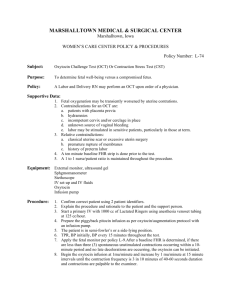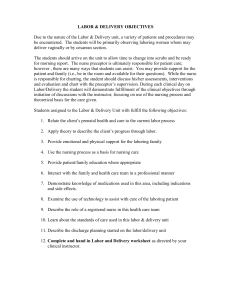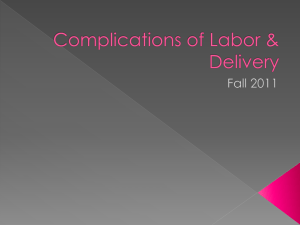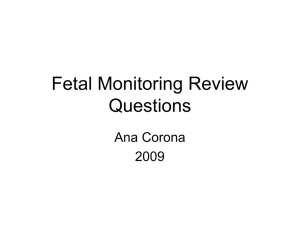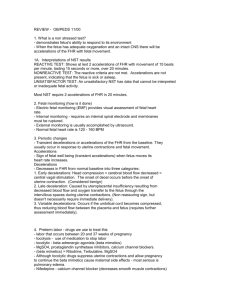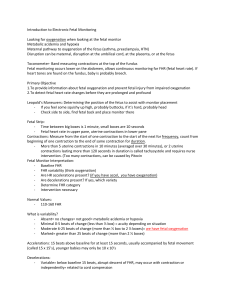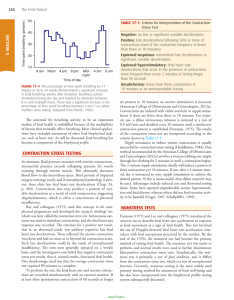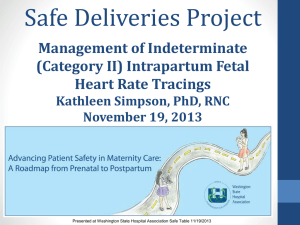Chapter 6 Nursing Care of Mother and Infant During Labor and Birth
advertisement
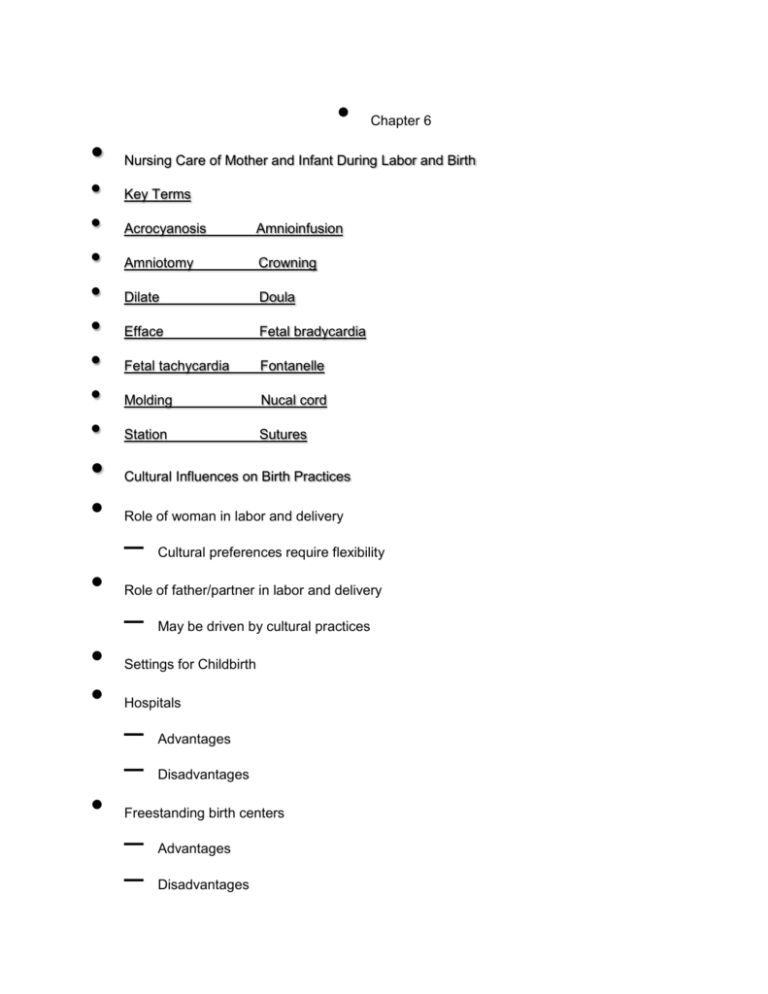
• • • • • • • • • • • • • • • • Chapter 6 Nursing Care of Mother and Infant During Labor and Birth Key Terms Acrocyanosis Amnioinfusion Amniotomy Crowning Dilate Doula Efface Fetal bradycardia Fetal tachycardia Fontanelle Molding Nucal cord Station Sutures Cultural Influences on Birth Practices Role of woman in labor and delivery – Cultural preferences require flexibility Role of father/partner in labor and delivery – May be driven by cultural practices Settings for Childbirth Hospitals – – Advantages Disadvantages Freestanding birth centers – – Advantages Disadvantages • • • • • • • • • • • • Home – – Advantages Disadvantages Components of the Birth Process The Four “Ps” – – – – Powers Passage Passenger Psyche Factors that Influence the Progress of Labor Preparation Position Professional Place Procedures People Uterine Contractions Effect of contractions on the cervix – – Efface Dilate • • • • • • • • • • • • Phase of contractions – – – Increment Peak Decrement Frequency Duration Intensity – – – Mild Moderate Firm Maternal pushing Cervical Effacement and Dilation Contraction Cycle Nursing Tip Provide emotional support to the laboring woman so she is less anxious and fearful Excessive anxiety or fear can cause greater pain, inhibit the progress of labor, and reduce blood flow to the placenta and fetus The Passage Bony pelvis – True • Directly involved in childbirth – • • • • • • • • • • • • • • – – – Inlet Midpelvis Outlet False • • Flares Upper portion of pelvis Soft tissues – – If previous delivery, will yield more readily to contractions and pushing efforts May not yield as readily in primiparas or older women The Passenger—Fetal Skull The Passenger—Fetal Lie The Passenger—Presentation Classifications of Fetal Presentations and Positions Psyche Mental state can influence the course of labor The woman’s cultural and individual values influence how she will cope with childbirth Normal Childbirth Signs of Impending Labor Braxton Hicks contractions Increased vaginal discharge Bloody show Rupture of the membranes • • • • • • • • • • • • • • • • • • • Energy spurt Weight loss Mechanisms of Labor Descent – Station Engagement Flexion Internal rotation Extension External rotation Expulsion Birth Station Mechanisms of Labor Admission to the Hospital or Birth Center When to Go to the Hospital or Birth Center Contractions Ruptured membranes Bleeding other than bloody show Decreased fetal movement Any other concern • • • • • • • • • • • Admission Data Collection Three major assessments performed promptly on admission – – – Fetal condition Maternal condition Impending birth Admission Procedures Permits/consents Laboratory tests Intravenous infusion Perineal prep Determining fetal position and presentation Comparison of False and True Labor False labor – – – – Contractions irregular Walking relieves contractions Bloody show usually not present No change in effacement/dilation of cervix True labor – – – – – Contractions gradually develop a regular pattern Contractions become stronger and more effective with walking Discomfort in lower back/abdomen Bloody show often present Progressive effacement and dilation of cervix • • • • • • • • • • • • • • • Nursing Care Before Birth After admission to the labor unit, nursing care consists of – – – Monitoring the fetus Monitoring the laboring woman Helping the woman cope with labor Monitoring the Fetus Fetal heart rate Intermittent auscultation Continuous electronic fetal monitoring Evaluating Fetal Heart Rate Patterns Baseline FHR – 110-160 BPM Fetal bradycardia – <110 BPM Fetal tachycardia – >160 BPM Baseline variability Moderate variability Marked variability Absent variability Accelerations – – – Early decelerations Variable decelerations Late decelerations – – – – • • • • • • • • • • • Prolonged decelerations Recurrent decelerations Intermittent decelerations Sinusoidal pattern Reassuring and Nonreassuring FHR and Uterine Activity Patterns Reassuring patterns – – – – Stable fetal heart rate (FHR) Moderate variability Accelerations Uterine contraction frequency greater than every 2 minutes; duration less than 90 seconds; relaxation interval of at least 60 seconds Nonreassuring patterns – – – – – Tachycardia Bradycardia Decreased or absent variability; little fluctuation in rate Late decelerations Variable decelerations Late Decelerations Monitoring the Woman Vital signs Contractions Progress of labor Intake and output Response to labor Six Lamaze Institute Basic Practices for Maternity Care • • • • • • • • • • • • • • • • • • Labor should begin on its own Woman should have freedom of movement Woman should have a birth support person or doula No routine interventions should be performed Woman should be in non-supine positions Woman should not be separated from infant Helping the Woman Cope with Labor Labor support Teaching Providing encouragement Supporting/teaching the partner – – – – Teach how labor pains affect the woman’s behavior/attitude How to adapt responses to the woman’s behavior What to expect in his/her own emotional responses Effects of epidural analgesia Stages and Phases of Labor First stage—dilation and effacement (can last 4 to 6 hours) Second stage—expulsion of fetus (30 minutes to 2 hours) Third stage—expulsion of placenta (5 to 30 minutes) Fourth stage—recovery Vaginal Birth After Cesarean Main concern • • • • • • • • • • • • • • • • • • Uterine scar will rupture Can disrupt placental blood flow Lead to hemorrhage Woman may need more support than other laboring women Nurse provides empathy and support Nursing Responsibilities During Birth Preparing the delivery instruments and infant equipment Perineal scrub Administering medications Providing initial care to the infant Assessing Apgar score Assessing infant for obvious abnormalities Examining the placenta Identifying mother and infant Promoting parent-infant bonding Immediate Postpartum Period: Third and Fourth Stages of Labor Third stage—expulsion of placenta – Schulze or Duncan’s Fourth stage—nursing care includes – Identifying and preventing hemorrhage • • – – – – – Observing bladder function and urine output Evaluating recovery from anesthesia Providing initial care to the newborn infant Promoting bonding and attachment between the infant and family Nursing Care Immediately After Birth Care of the mother – – • • Evaluating and intervening for pain Observing for hemorrhage • • • • • Vital signs Skin color Location and firmness of uterine fundus Lochia Pain Promoting comfort • • Keep warm and dry Ice to perineum to help reduce swelling and bruising Nursing Care Immediately After Birth (cont.) Care of the infant – – – Phase 1 • From birth to 1 hour (usually in delivery room) Phase 2 • From 1 to 3 hours (usually in transition nursery or postpartum unit) Phase 3 • From 2 to 12 hours (usually in postpartum unit if rooming-in with the mother) • • • • • • • • • • • • • • • Phase 1: Care of the Newborn Initial care includes – – – – – – Maintaining thermoregulation Maintaining cardiorespiratory function Observing for urination and/or passage of meconium Identifying the mother, father, and newborn Performing a brief assessment for major anomalies Encouraging bonding/breastfeeding Care of the Newborn Apgar Scoring Heart rate Respiratory effort Muscle tone Reflex response to suction or gentle stimulation on the soles of the feet Skin color Administering Medications to the Newborn Eye care Vitamin K (AquaMEPHYTON) Observe for Major Anomalies Head trauma from delivery Symmetry and equality of extremities • • • • • • – – Are they of equal length? Do they move with same vigor on both sides? Assess digits of hands and feet – Any evidence of webbing or abnormal number of digits Umbilical Cord Blood Banking This type of blood is capable of regenerating stem cells that are able to replace diseased cells Informed consent is essential Collect blood after cord has been clamped Blood must be transported within 48 hours of collection to blood banking facility
